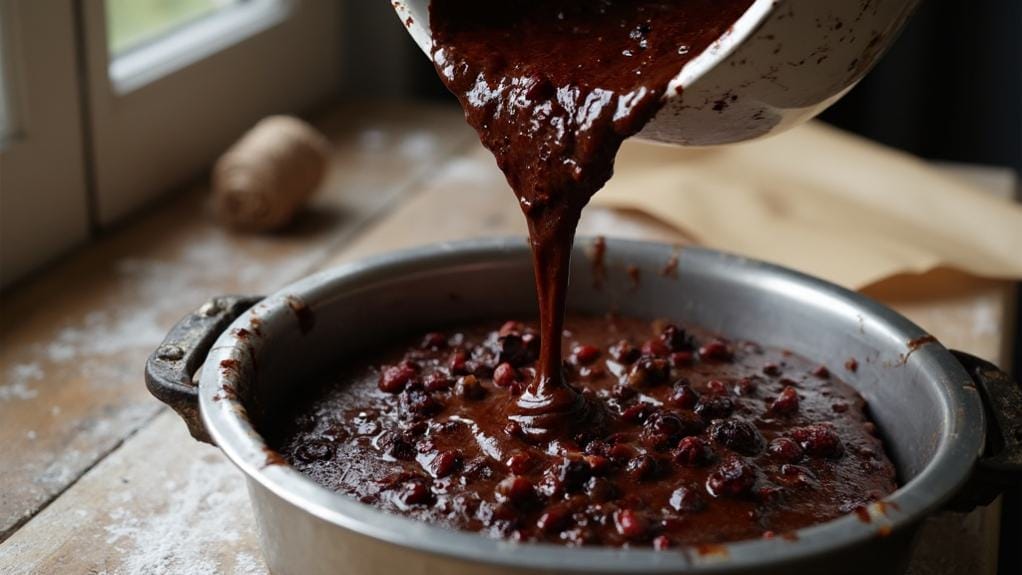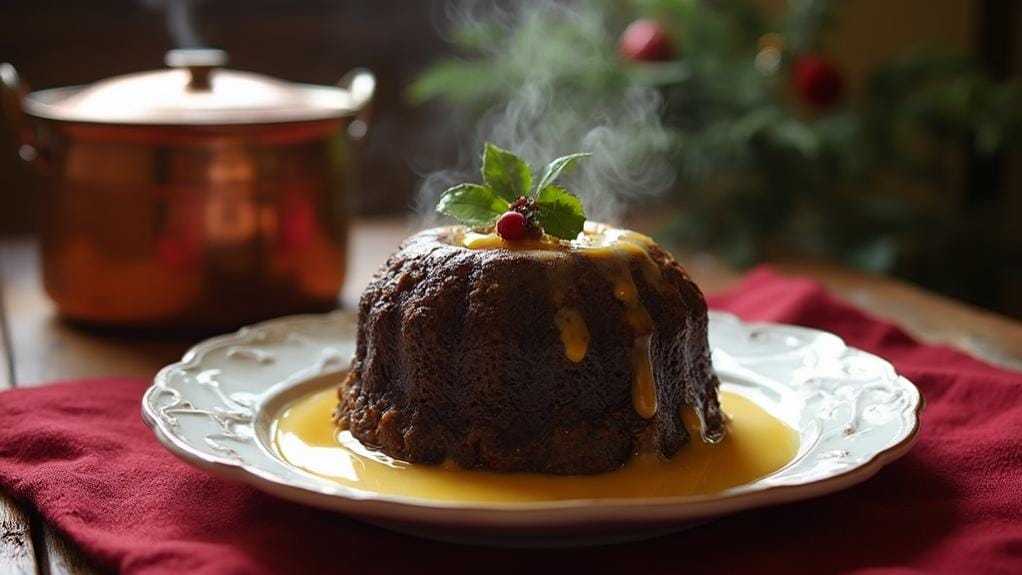Studies show that over 40% of holiday hosts now accommodate vegan guests at their Christmas celebrations, making traditional dessert alternatives more important than ever. I’ve spent years perfecting my vegan Christmas pudding recipe, transforming the Victorian classic into a plant-based masterpiece that honors its rich heritage while embracing modern dietary needs.
The secret lies not just in the ingredients, but in understanding how each component contributes to that characteristic dense, moist texture we all cherish. Let me share how I’ve mastered this festive centerpiece that even non-vegans can’t resist.
Recipe
This traditional holiday dessert has been reimagined without any animal products while maintaining its rich, festive character. The combination of dried fruits, warming spices, and plant-based ingredients creates a perfectly moist and decadent pudding that rivals its conventional counterpart.
The key to success lies in proper preparation and patience. The dried fruits need adequate soaking time to become plump and flavorful, while the steaming process ensures the pudding develops its characteristic dark color and dense texture. This version uses vegetable suet and plant milk to achieve the same indulgent results as the traditional recipe.
- 300g mixed dried fruit (raisins, sultanas, currants)
- 100g dried cranberries
- 100g dried figs, chopped
- 100ml brandy
- 250g self-raising flour
- 150g dark brown sugar
- 125g vegetable suet
- 100g breadcrumbs
- 2 tsp mixed spice
- 1 tsp ground cinnamon
- 1/2 tsp ground nutmeg
- 1 orange, zested
- 1 lemon, zested
- 250ml plant-based milk
- 2 tbsp black treacle
- 1 tbsp apple cider vinegar
Soak the dried fruits in brandy overnight in a covered bowl. The next day, mix all dry ingredients in a large bowl. Add the soaked fruits with any remaining liquid, plant milk, treacle, and vinegar. Stir until thoroughly combined.
Grease a 1.2L pudding basin and transfer the mixture into it. Cover with parchment paper and foil, securing tightly with string. Place the basin in a large pot with boiling water reaching halfway up its sides. Steam for 6 hours, maintaining water levels throughout cooking. Once done, remove from heat and allow to cool completely.
For optimal flavor, prepare this pudding at least one month before serving, storing it in a cool, dark place. When ready to serve, steam for an additional hour to heat through.
The pudding can be made alcohol-free by replacing brandy with apple juice or strong black tea. Always ensure the water level is maintained during steaming to prevent the pot from boiling dry. The pudding can be frozen for up to a year, and individual portions can be reheated in the microwave for 1-2 minutes.
Step-By-Step Cooking Instructions
You’ll begin your vegan Christmas pudding journey by soaking your dried fruits overnight in rich brandy, allowing them to plump up and absorb the spirit’s complex flavors.
Next, you’ll combine your dry ingredients in a large mixing bowl before incorporating the soaked fruits and remaining wet ingredients, stirring until you’ve achieved a well-balanced mixture.
Finally, you’ll transfer your mixture to a prepared pudding basin and steam it for six hours, resulting in a perfectly moist, dark pudding that’s worthy of your holiday table.
Step 1. Soak Fruits in Brandy

The luxurious aroma of brandy-soaked fruit sets the foundation for this decadent Christmas pudding.
You’ll begin this crucial first step by combining your dried fruits – the raisins, sultanas, currants, cranberries, and chopped figs – in a large, non-reactive bowl.
Pour the brandy over your fruit mixture, ensuring every piece is touched by the spirit’s warming embrace.
For optimal results, you’ll want to cover your bowl with a tight-fitting lid or plastic wrap, then let it rest in a cool, dark place for a minimum of 12 hours, though 24 hours will yield superior results.
During this time, the fruits will slowly absorb the brandy, becoming plump and intensely flavored.
You’ll notice they’ll swell considerably, their natural sweetness enhanced by the spirit’s complex notes.
If you’re opting for an alcohol-free version, you can substitute the brandy with freshly brewed strong black tea or pure apple juice.
While these alternatives won’t deliver the same depth of flavor, they’ll still ensure your fruits achieve the necessary moisture content for a properly textured pudding.
Step 2. Mix Dry Ingredients Together

Sifting together the dry ingredients creates the aromatic foundation for this luxurious pudding.
Begin by placing a large, fine-mesh sieve over your mixing bowl, then carefully measure out the self-raising flour, ensuring you’ve leveled each cupful precisely. Add the dark brown sugar, ensuring there aren’t any stubborn lumps that might compromise your pudding’s texture.
In the same bowl, introduce the vegetable suet and breadcrumbs, which will provide the essential structure and richness to your festive creation.
Now comes the magical mixture of spices: precisely measure the mixed spice, ground cinnamon, and nutmeg, allowing each one’s distinct aroma to perfume your kitchen. Don’t forget to add both the orange and lemon zest, gently rubbing them between your fingers to release their fragrant oils.
Using a whisk, combine these dry ingredients with a deliberate, thorough motion, ensuring every component is evenly distributed.
You’ll want to pay special attention to breaking up any remaining sugar clusters and incorporating the spices uniformly throughout the mixture. This meticulous preparation ensures your pudding will have consistent flavor in every decadent bite.
Step 3. Combine Wet With Dry

After your meticulously prepared dry ingredients beckon, it’s time to introduce the luscious wet components with practiced precision. Pour your brandy-soaked fruit mixture into the bowl, ensuring every plump, alcohol-infused morsel finds its way into the blend.
Next, introduce the plant-based milk in a steady stream while gently folding the mixture with a wooden spoon. Drizzle the black treacle with deliberate care, watching as its dark, glossy ribbons cascade into the bowl.
Add the apple cider vinegar, which will react with your self-raising flour to create the perfect rise. Using broad, confident strokes, fold everything together until you’ve achieved a consistently dark, sumptuous mixture.
You’ll know you’ve reached the ideal consistency when the batter falls heavily from your spoon, leaving a momentary ribbon on the surface. Don’t be tempted to overmix – you’re seeking a harmonious marriage of ingredients where each component maintains its integrity while contributing to the whole.
The final mixture should be dark, rich, and gloriously speckled with fruit, ready for its transformation in the pudding basin.
Step 4. Transfer to Pudding Basin

Now comes the most crucial moment in your pudding’s journey – transferring your lovingly prepared mixture to its waiting basin. Before you begin, ensure you’ve greased your 1.2L pudding basin thoroughly, paying special attention to the base and any grooves or patterns that might cause sticking.
Spoon your rich mixture into the basin gradually, taking care to press it down firmly as you go. This step is essential to eliminate any air pockets that could affect the pudding’s texture.
Once you’ve added all the mixture, smooth the surface with the back of a spoon, creating a slight dome shape to allow for expansion during steaming.
Cut a circle of parchment paper slightly larger than your basin’s diameter and place it directly on the pudding’s surface. Follow this with a larger circle of foil, creating a sharp pleat down the middle to allow for expansion.
Secure both layers tightly around the basin’s rim with kitchen string, then create a string handle by crossing two lengths over the top. This will make it easier to lift your pudding in and out of the steaming pot later.
Step 5. Steam Pudding and Serve

The gentle art of steaming transforms your carefully crafted mixture into a luxurious Christmas pudding worthy of any festive table.
Lower your covered pudding basin into a large pot filled with boiling water, ensuring the water reaches halfway up the basin’s sides. Maintain a gentle simmer for six hours, checking periodically to replenish the water level as needed.
Once steamed, remove your pudding from the pot and let it cool completely. You’ll notice its rich, dark color and firm texture – hallmarks of a properly prepared Christmas pudding.
Store it in a cool, dark place for at least a month, allowing the complex flavors to mature and meld together beautifully.
On Christmas Day, steam your pudding for an additional hour to heat it through. Turn it out onto a warmed serving plate, where it should release easily, maintaining its distinctive domed shape.
Serve immediately with your choice of vegan accompaniments – perhaps a silky custard, warming brandy sauce, or creamy plant-based ice cream.
Watch as your guests delight in this masterful recreation of a beloved holiday tradition.
Why I Love This Dish
Holiday memories come flooding back whenever I prepare this sumptuous vegan Christmas pudding, which perfectly captures the essence of traditional festivities while aligning with my plant-based values. The rich aroma of mixed spices, citrus zest, and brandy-soaked fruits transforms my kitchen into a haven of nostalgic comfort.
I’m particularly drawn to how this recipe honors the time-tested techniques of pudding making while innovating through plant-based alternatives. The careful balance of dried fruits creates layers of natural sweetness, while the vegetable suet delivers that characteristic dense, moist texture I’ve always cherished in traditional versions.
What I treasure most is watching my guests’ expressions when they discover it’s vegan. The pudding’s deep, dark appearance and complex flavors never fail to impress, proving that plant-based desserts can be just as luxurious as their conventional counterparts.
Each spoonful delivers the same warmth and satisfaction I remember from childhood celebrations, yet I can now share this joy with everyone at my table, regardless of their dietary choices. It’s a dish that embodies both tradition and progress, making it truly special to me.

Leave a Reply